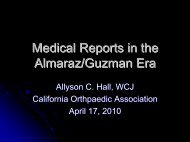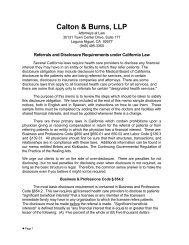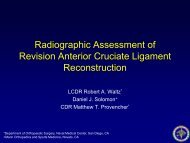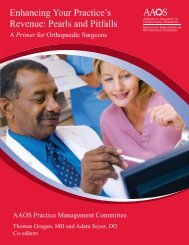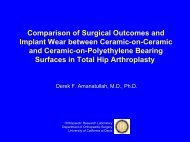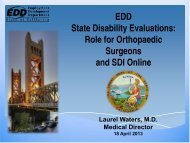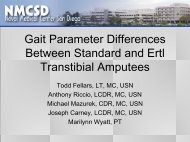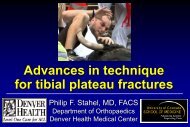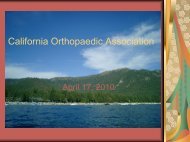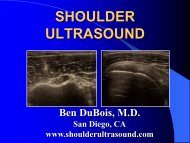Mike Millis, M.D., Boston Children's Hospital
Mike Millis, M.D., Boston Children's Hospital
Mike Millis, M.D., Boston Children's Hospital
You also want an ePaper? Increase the reach of your titles
YUMPU automatically turns print PDFs into web optimized ePapers that Google loves.
Hipology 2010<br />
COA Meeting<br />
April 17, 2010
Hip Joint-Preserving Surgery:<br />
An Etiologic Approach to Prevent and<br />
Treat Osteoarthrosis<br />
Michael B. <strong>Millis</strong>, M.D.<br />
Director, Adolescent and Young Adult Hip Unit<br />
Children’s <strong>Hospital</strong>/Harvard Medical School
Disclosures<br />
• None relevant to this presentation<br />
• Hip Unit research support from Siemens (YJK)
Major Points<br />
* In North America, most OA in the hip is secondary<br />
• Developmental hip deformity is the commonest etiology of this secondary OA<br />
• A mechanical perspective is very helpful in understanding the nature of<br />
secondary hip OA<br />
(i.e., most OA in the hip is caused by abnormal mechanics)<br />
* Accurate analysis of the mechanical hip abnormality can often allow its surgical<br />
correction (and prevent OA!!)<br />
• Instability and impingement are the common bad actors<br />
• The acetabular rim is the usual locus of early damage<br />
– The labrum is often damaged but labral tears rarely can be repaired successfully in<br />
isolation<br />
– (>90% of labral tears have important associated bony abnormalities)<br />
* Joint-preserving hip surgery can be highly effective IF performed before there is<br />
major articular cartilage damage
Major Points<br />
* In North America, most OA in the hip is secondary<br />
(Most OA in the hip is caused by abnormal mechanics)<br />
* Accurate analysis of the mechanical hip abnormality can<br />
often allow its surgical correction (and prevent OA!!)<br />
* Joint-preserving hip surgery can be highly effective IF<br />
performed before there is major articular cartilage<br />
damage
Acknowledgements<br />
• Classic Teachers: Pauwels; Bombelli, Maquet<br />
• Basic Researchers: Mankin, Buckwalter,<br />
Grodzinky et al<br />
• Great Joint-Saving Surgeons: Ganz, Mueller,<br />
Ninomiya, Salter, Sugioka,Wagner<br />
* Mentors: Ganz, Hall, Harris, Wagner<br />
• Colleagues: Felson, Jaramillo, Kim and CHB Hip Unit,<br />
Leunig, Murphy, Poss, Santore et al; ANCHOR Group<br />
• Our patients
“It seems clear that either osteoarthritis of the<br />
hip does not exist as a primary disease entity<br />
or if it does, is extraordinarily rare.”<br />
William H. Harris
Risk Factors for Osteoarthritis:<br />
Understanding Joint Vulnerability<br />
• “Risk factors for OA can be best understood<br />
as either:<br />
1) impairment of joint protectors<br />
→increasing joint vulnerability OR<br />
2) factors that excessively load the joint<br />
OR BOTH<br />
----leading to injury.”<br />
CORR 427S:16-21, 2004 D Felson
Joint Function<br />
Activity level<br />
Instability<br />
Impingement<br />
Time
“The best hip replacement has an unknown<br />
but certainly finite life, whereas a hip healed<br />
after osteotomy will often last a lifetime.”<br />
Prof. Maurice Mueller
“We see what we know.”<br />
Frank Phillip Stella, artist
“We see what we know.”<br />
18 yo son; mild groin pain 43 yo father; R>>L<br />
groin pain<br />
Bilateral crossover signs and posterior wall signs
The Contemporary Mechanical<br />
Theory of Osteoarthrosis in the Hip<br />
• OA in the hip usually is SECONDARY:<br />
a final common pathway of mechanicallybased<br />
degradation rather than a distinct disease
The Contemporary Mechanical<br />
Theory of Osteoarthrosis in the Hip<br />
• OA in the hip usually is secondary: mechanically-based<br />
degradation rather than a distinct disease<br />
* Major etiologic factor in hip OA: loading of the<br />
acetabular rim, by instability or impingement
Etiology of OA of the<br />
Hip-1986<br />
• Dysplasia 43%<br />
• Perthes Disease 22%<br />
• Slipped Epiphysis 11%<br />
• Other 12%<br />
* “Idiopathic”/”Primary” 12%<br />
(Many were probably<br />
impinging hips!!)<br />
(Aronson, AAOS Instr. Course<br />
Lec. 35:119-128, 1986)
MAJOR POINTS<br />
* Hip OA is rarely idiopathic.<br />
* Hip OA usually begins at the acetabular RIM.<br />
* Labral tears are usually secondary lesions.<br />
* Wenger D et al: “Acetabular labral tears rarely<br />
occur in the absence of bony abnormalities”<br />
Clin Orthop Relat Res 2004: 426:145-150.
MAJOR POINTS<br />
* A labral tear is usually SECONDARY<br />
to another structural problem (90+%!!)
MAJOR POINTS<br />
* Hip OA is rarely idiopathic.<br />
* Hip OA usually begins at the RIM.<br />
* Labral tears are usually secondary lesions.<br />
* Joint-preserving procedures are effective IF they<br />
correct the hip’s mechanical problem in time.
Acetabular Rim Syndrome(s)<br />
• Groin/thigh pain with certain maneuvers<br />
• Sensation of locking/catching/instability<br />
• Labral damage, cartilage damage, or rim fractures from<br />
either: instability(DDH) OR<br />
femoro-acetabular impingement (FAI)<br />
(Klaue et al: JBJS, 73-B: 423-429, 1991)
Principles of Joint Preservation<br />
• Key Initial Questions<br />
– Is there a MECHANICAL BASIS<br />
for part or all of the clinical<br />
problem<br />
– (Is there a correctable mechanical<br />
problem)<br />
– Can a MECHANICALLY-BASED<br />
joint-preserving technique improve<br />
clinical function or the prognosis
Step-Wise Analysis of the<br />
Symptomatic Hip<br />
• Is there a correctable mechanical lesion YES<br />
• How can the mechanical lesion be corrected<br />
* Is hip preservation preferable to replacement arthroplasty<br />
for this patient
Hard Truths<br />
(Bad News)<br />
• No good substitute yet for hyaline cartilage<br />
• Biologic resurfacing is difficult AT BEST.<br />
• OA is progressive UNLESS the unfavorable<br />
mechanics within the joint can be fixed.
Good News About OA in the Hip<br />
• Rarely idiopathic or “primary”<br />
• Mechanical nature, familiar to the orthopaedist<br />
• Treatable/preventable by mechanical means<br />
* Several joint-preserving alternatives exist<br />
• Arthroscopy<br />
• Arthrotomy<br />
* Surgical hip dislocation/osteoplasty/debridement<br />
• Realignment osteotomy(Femoral or pelvic)<br />
• (Biologic resurfacing of articular surfaces)<br />
• Combinations
Goals for Every Orthopaedist<br />
* Learn to recognize the mechanicallycompromised<br />
joint before arthrosis occurs<br />
* Learn how to save/preserve those joints<br />
rather than replacing them<br />
(if possible and reasonable)
The Normal Hip:<br />
Anatomic Characteristics<br />
• Congruous, well-aligned surfaces<br />
• “Good” coverage: not too little; not too much!<br />
• Normal version: A and P rims<br />
• Symmetric, wide cartilage space<br />
• Thin, almost horizontal sourcil: the weight-bearing zone
The Normal Hip: Anatomic Characteristics<br />
• Congruous, well-aligned surfaces<br />
• “Good” coverage: not too little; not too much!<br />
– Lateral C-E angle 25-35°<br />
• Normal version: A and P rims<br />
– No crossover sign; rims meet at corner of acetabulum<br />
• Symmetric, wide cartilage space<br />
• Thin, almost horizontal sourcil: the weight-bearing zone<br />
– Tönnis roof angle: 0 to 10°
The Normal Hip:<br />
Mechanical Characteristics<br />
• Free mobility: ROM>needed for ADL<br />
• Stability<br />
• Narrow physiologic range of loading
• Anatomy:<br />
“Normal” Hip<br />
• Spherical head congruous with spherical<br />
acetabulum in all positions<br />
• “Sufficient” head-neck offset;<br />
“normal” version<br />
• “Sufficient” coverage without overcoverage<br />
• Mechanics : Motion should be MORE<br />
than needed for ADL<br />
* Motion smooth/gliding/non-jamming<br />
throughout ROM<br />
* Stability; tolerable contact conditions<br />
throughout ROM
Important Definitions<br />
• Instability: the mechanical environment at<br />
the rim in acetabular dysplasia<br />
– Shearing stresses on cartilage<br />
– High loads on rim
Important Definitions<br />
• Femoro-acetabular<br />
impingement: abnormal<br />
dynamic contact/”conflict”<br />
between the proximal femur and<br />
acetabular rim, and the adjacent<br />
acetabular cartilage<br />
– FAI is a clinical diagnosis,<br />
NOT an imaging diagnosis
Hip Mechanics<br />
(INSTABILITY) (IMPINGEMENT)<br />
“The human hip represents an uneasy compromise between the<br />
need for stability in a joint that transmits loads of several times our<br />
body weight and the need to provide movement.<br />
..Any geometric restriction has the potential to cause damage.”<br />
RE Field, e-commentary JBJS 87B, 2005
How can joints go wrong mechanically<br />
• Abnormal anatomy; “normal” use leads to<br />
articular damage over time
How can joints go wrong mechanically<br />
• Abnormal anatomy; “normal” use leads to<br />
articular damage over time
How can joints go wrong mechanically<br />
• Abnormal anatomy; “normal” use<br />
* Normal anatomy; abnormal use exceeds<br />
tolerance of joint structures<br />
Acute injury → → → →<br />
Chronic abuse/overuse<br />
(occupational, recreational)
Hip Mechanics<br />
• IMPINGEMENTINSTABILITY<br />
(SCFE, Perthes) (DDH)
Etiologies of Hip OA in North<br />
America-UPDATED<br />
• Dysplasia 43%<br />
Perthes-Impingement 22%<br />
SCFE-Impingement 11%<br />
* Non-Perthes, non-SCFE FAI >10%<br />
“Impingement-related” 43%<br />
• Idiopathic + Other 16%<br />
(modified from Aronson, 1986)
Femoro-Acetabular<br />
Impingement as a Cause of OA<br />
• “Classical” Impingement: Pauwels, Bombelli<br />
– Intraarticular incongruity; “static” overload
Femoro-Acetabular Impingement<br />
as a Cause of OA<br />
* “Contemporary” Hypothesis:<br />
(Ganz et al)<br />
Abnormal dynamic contact<br />
between proximal femur and<br />
acetabulum causes damage to rim<br />
and adjacent acetabular<br />
cartilageOA
Femoro-Acetabular Impingement<br />
• Femur-based: Cam type, from cam-shaped<br />
femoral head-neck junction (b)<br />
• Acetabulum-based: Pincer type, from acetabular<br />
overcoverage or retroversion (c)<br />
• Combination: Cam and Pincer (d) (very common)
Femur-based FAI: Cam Impingement<br />
• Pathoanatomy: asphericity of<br />
head or insufficient offset at<br />
head-neck junction<br />
• Pathomechanics:<br />
jamming/squeezing of anterior<br />
acetabular cartilage(+++)<br />
and labrum(+) in flexion
Femoro-Acetabular Impingement<br />
as a Cause of OA<br />
Femoro-acetabular impingement<br />
causes damage to rim and adjacent<br />
acetabular cartilageOA<br />
* THR analogy:<br />
Impingement between components<br />
due to poor prosthetic design or<br />
malorientation
Femoro-Acetabular Impingement<br />
(Ganz et al)<br />
• Similar to THR impingement due to<br />
component “design flaws”:<br />
the native hip can have impingementproducing<br />
anatomic patterns!!!!!
Herniation pit; usually<br />
means cam- type FAI<br />
Ortho Uni Berne
Ortho Uni Berne
Femur-based FAI: Cam Impingement<br />
• Pathoanatomy: asphericity of head or insufficient offset at headneck<br />
junction<br />
• Pathomechanics: jamming/squeezing of anterior acetabular<br />
cartilage(+++) and labrum(+)<br />
* Damage pattern: anterolateral rim;<br />
* Cartilage>>labrum!<br />
* Cartilage>>labrum!!<br />
* Cartilage >>labrum!!!
Schematic FAI<br />
• Thanks to Dr. Ira Zaltz for the following<br />
diagrams and software
CAM Impingement-Mechanism<br />
CAM Type
Impingement of<br />
Acetabular labrum
Delamination of<br />
Cartilage
Pathology Seen w. Cam Impingement<br />
• Outside-in abrasion of ant. acetabular cartilage<br />
in flexion<br />
* Chondral flaps avulsed from inner labral edge<br />
• Degeneration of labrum (less damage than to<br />
adjacent articular cartilage)<br />
• Intact femoral head cartilage till very late!<br />
Ganz et al: CORR 417:112-120, 2003; Beck et al
Ortho Uni Berne
Ortho Uni Berne
Ortho Uni Berne
Cam Impingement:<br />
Location of acetabular cartilage lesions<br />
• Chondral bruising, flap, or full-thickness loss<br />
primarily from 11 o’clock to 1 o’clock<br />
(anterosuperior)
(pincer)<br />
M:F = 4:12<br />
pistol grip/ cam<br />
M:F = 28:2<br />
4mm<br />
11mm<br />
post<br />
ant<br />
post<br />
ant<br />
33<br />
%<br />
R<br />
R
Femur-Based F-A Impingement:<br />
“Cam Impingement”<br />
• Anatomic causes:<br />
Femoral Head:<br />
Asphericity (Perthes, etc)<br />
Retrotilt (SCFE)<br />
No anterior offset<br />
(SCFE, idiopathic, etc.)<br />
Femoral Neck:<br />
Retroversion<br />
Coxa vara<br />
Femoral neck malunion
Etiologies of Hip OA in North<br />
America-UPDATED<br />
• Dysplasia 43%<br />
Perthes-Impingement 22%<br />
SCFE-Impingement 11%<br />
* Non-Perthes, non-SCFE FAI >10%<br />
“Impingement-related” 43%<br />
• Idiopathic + Other 16%<br />
(modified from Aronson, 1986)
Acetabulum-based (Pincer) FAI<br />
as a Cause of OA<br />
Anterior impingement<br />
causes damage to rim<br />
and adjacent acetabular<br />
cartilageOA<br />
* THR analogy:<br />
Impingement due to cup<br />
retroversion
Acetabulum-Based Femoro-<br />
Acetabular Impingement:<br />
“Pincer Impingement”<br />
• Anatomic causes:<br />
* Retroversion: crossover sign; posterior wall sign<br />
• Overcoverage: protrusio or coxa profunda
Ortho Uni Berne
“We see what we know.”<br />
Frank Phillip Stella, artist
Pincer Impingement<br />
• Extensive direct damage by femoral neck to<br />
overhanging anterior and anterolateral rim/labrum<br />
and adjacent articular cartilage<br />
• Contrecoup lesions of posteroinferior joint<br />
“Hip morphology influences the pattern of damage<br />
to the acetabular articular cartilage”<br />
Beck et al: JBJS 87-B:1012-1018, July 2005
Pincer Impingement-Mechanism<br />
PINCER Type
Mechanical Damage<br />
Contrecoup<br />
Injury
Impingement of<br />
Acetabular Rim<br />
Contrecoup<br />
Injury
Tearing of Labrum<br />
Contrecoup<br />
injury
Protusio<br />
Ortho Uni Berne
Pincer Impingement<br />
• Pathoanatomy: deep or retroverted socket<br />
• Pathomechanics: neck crushes labrum<br />
directly around a wide portion of rim<br />
• Damage pattern: circumferential area of<br />
labral crush injury; shallow zone of lesser<br />
indirect damage to adjacent acetabular<br />
cartilage (labral damage>cartilage damage)
Campincer Impingement<br />
• Commonest pattern: ~70%<br />
• Pathoanatomy: cam AND pincer patterns<br />
• Pathomechanics: cam AND pincer patterns<br />
• Damage pattern: cam AND pincer patterns
Contemporary Concept of<br />
Impingement-Based Arthrosis<br />
* Chronic impingement with motion<br />
causes mechanical damage to the<br />
acetabular rim and adjacent cartilage<br />
* Mechanically-based treatment goal:<br />
Improvement in joint clearance for<br />
ADL!
Clinical Evaluation for Femoro-<br />
Acetabular Impingement<br />
• History: Groin ache worse with flexion<br />
* Physical Exam<br />
* 1. Limited flexion>lim int rot>lim abd<br />
OFTEN>IR!!!<br />
* 3. Anterior Impingement Test<br />
(pain on passive F/Add/IR)
The contour of the femoral headneck<br />
junction as a predictor for the<br />
risk of anterior impingement<br />
• Nötzli HP et al JBJS 84-B: 556-560, 2002
Contour of the Head-Neck Junction and<br />
Cam-Type FAI: The Alpha Angle<br />
• Measures angle from center of neck to the<br />
anterior margin of the head-neck junction<br />
• Measured on axial MRI or true lateral film<br />
• Smaller angle is better; less risk of FAI<br />
normal(α
Imaging for F-A Impingement<br />
• Plain Radiography<br />
• MRI/MR Arthrography (MRA)<br />
– MRA best for diagnosing labral lesions<br />
* MRA with radial sequences best for finding certain<br />
impingement patterns (Locher et al, Z Orthop 140:<br />
52-57, 2002)
Imaging for F-A Impingement<br />
• Plain Radiography<br />
• MRI/MR Arthrography (MRA)<br />
• CT Scan: With distal femoral cuts, can measure<br />
femoral version; with 3D reconstruction, can<br />
show asphericity and reduced-offset areas
Imaging for F-A Impingement<br />
• Plain Radiography<br />
• MRI/MR Arthrography (MRA)<br />
•CT Scan<br />
• Arthroscopy<br />
– Can find cartilage lesions not<br />
otherwise found<br />
* BUT: Dynamic assessment<br />
difficult 2° to traction
Analysis for F-A Impingement<br />
• Plain Radiography<br />
• MRI/MR Arthrography (MRA)<br />
•CT Scan<br />
• Arthroscopy<br />
* Surgical dislocation/arthrotomy (Ganz, 2001)<br />
* Excellent DYNAMIC assessment and visualization<br />
(but much more invasive than arthroscopy)<br />
* (and excellent for direct intraarticular treatment)
Treatment Options for Impingement<br />
• Extra-articular procedures<br />
– Proximal femoral osteotomies: ITO, esp. valgus<br />
– Acetabular procedures: “Reverse” PAO; Chiari<br />
* Intra-articular procedures<br />
– Trimming of femoral head<br />
– Subcapital osteotomy<br />
– Rim trim<br />
– Combinations
Treatment of pincer impingement<br />
(protrusio or coxa profunda)<br />
• Rim trim, with labral refixation if possible
Treatment of cam deformities<br />
• Femoral head/neck osteochondroplasty
Treatment of combined femoral and<br />
acetabulum-based FAI (~70%)<br />
* Rim trim with labral refixation<br />
if possible (Espinosa, 2006)<br />
* Femoral head/neck offset creation<br />
* Other debridement, microfx as needed
“Safe” Surgical Hip Dislocation:<br />
A New Tool for Extensive<br />
Intraarticular Surgery<br />
• Ganz: >1500 hips over 15 y;<br />
1 case AVN w fem neck fx<br />
• Ant. disloc/Gibson approach<br />
• Troch. flip osteotomy<br />
• Very useful for impinging<br />
hips; allows relocation to<br />
assess motion/impinging<br />
(Ganz et al: JBJS 83-B(8):<br />
1119-1124, 2001.
Prerequisite for “Safe” Surgical Hip<br />
Dislocation:<br />
* Knowledge of blood supply to femoral head<br />
* Technique to dislocate and do intra-articular<br />
work without disturbing blood supply to the<br />
femoral head
Surgical Technique<br />
• Exactly as per Ganz et al<br />
• Lateral position/Gibson approach/troch flip<br />
• peripheral capsulotomy<br />
* Spare obturator externus<br />
• Anterior dislocation<br />
• Intraarticular surgery as needed<br />
• Occasional simultaneous ITO
Surgical Dislocation Technique<br />
• Diagrams and concept: Professor Ganz<br />
• Intraop photos: Young-Jo Kim, M.D., Ph.D.
Step I<br />
Step II<br />
Ortho Uni Berne<br />
Ortho Uni Berne<br />
Step III<br />
Step IV<br />
Step V<br />
Ortho Uni Berne<br />
Ortho Uni Berne<br />
Ortho Uni Berne
Lateral Position
ANTERIOR<br />
Trochanteric<br />
Branch of the<br />
MFC<br />
FEET<br />
HEAD<br />
Posterior edge of<br />
gluteus medius<br />
OE<br />
Q<br />
Vastus<br />
Tubercle
Greater<br />
Trochanter<br />
Piriformis<br />
Tendon<br />
OE<br />
Q<br />
MFCA
Greater<br />
Trochanter<br />
Anterior Hip<br />
Capsule<br />
Blood supply<br />
Trochanteric<br />
Base
Femoral Head<br />
Acetabulum
Potential Uses for the Surgical<br />
Dislocation Approach<br />
• Post-traumatic problems<br />
– Pipkin fractures of the femoral head<br />
– Incompletely reduced hip dislocations with<br />
incarcerated soft tissue or loose bodies<br />
– Acetabular fractures of the posterior wall<br />
• All types of FAI<br />
• SCFE: femoral neck osteoplasty OR<br />
Dunn/cuneiform osteotomy of neck
Improved Access
Improved Safety
Early Harvard Experience with<br />
Surgical Hip Dislocation<br />
• 300+ dislocations, 60+ subluxations since 8/01<br />
Followup: 1 to 5 years on 85 hips<br />
• Age at surgery: 8-48 years (mean 24)<br />
• Variety of mechanical disorders treated<br />
• AVN only in 4 complex cases (details to follow)
Insufficient Head-Neck Offset<br />
• 18 yoTae Kwan Do participant with R groin pain.<br />
Right is his main kicking leg.<br />
Groin ache with sitting.<br />
Positive anterior impingement test
Pre-op, postop offset creation by neck<br />
osteoplasty
• 20 yo hockey goalie; 5 yr hx groin pain sitting;<br />
increasing groin pain with sports<br />
• Flexion 90 degrees; IR 0 degrees<br />
• XR: crossover sign and neck “bump”
• Acknowledgement to Professor R.Ganz for<br />
inspiration, guidance, and intraop photos
SCFE - osteoplasty
Cartilage Delamination due to<br />
Impingement
Points on Femoro-Acetabular<br />
Impingement<br />
• FAI is common, but commonly MISSED!!<br />
• Cam and pincer combination is much more<br />
common than either alone!!<br />
(Beck et al: JBJS 87-B: 1012-1018, 7/2005)<br />
• Late treatment and undertreatment seem the<br />
commonest causes of treatment failure
Outcome depends on pre-existing<br />
damage in joint!
Clinical Evaluation for Femoro-<br />
Acetabular Impingement<br />
• History: Groin ache worse with flexion<br />
* Physical Exam<br />
* 1. Limited flexion>lim int rot>lim abd<br />
OFTEN>IR!!!<br />
* 3. Anterior Impingement Test<br />
(pain on passive F/Add/IR)
Hip Joint-Preserving Techniques<br />
Extra-articular Intra-articular<br />
• Classic Osteotomy<br />
Prox. Femoral (ITO)<br />
Pelvic (PAO, etc.)<br />
• Arthroscopy<br />
• Anterior Arthrotomy<br />
• Surgical Dislocation
Points on Surgical Dislocation Approach<br />
• Is an approach rather than a<br />
specific procedure<br />
* Allows extensive dynamic<br />
intraarticular assesment<br />
* Full dislocation not<br />
mandatory<br />
* Associated ITO possible<br />
* Vascularity to femoral head<br />
is reliable and easily<br />
protected<br />
* Results depend on primary<br />
problem
Hip Arthroscopy<br />
• What it IS: A surgical approach to the hip joint,<br />
with special(evolving!) instrumentation, which<br />
allows “closed but visible”intra-articular surgery<br />
• What it is NOT:<br />
NON-invasive/atraumatic<br />
Technically easy/user-friendly<br />
Useful for malalignment problems<br />
Magic
Extra-articular Impingement Relief<br />
for SCFE by ITO<br />
• Severe impingement in flexion from neck bump<br />
and posterior head tilt; can’t sit well<br />
• Rim changes on XR; risk for arthrosis
Slipped Capital Femoral Epiphysis<br />
• 14 yo F with L>>R groin pain with sitting;<br />
Anterior femoro-acetabular impingement<br />
Acetabulum<br />
Overcoverage with<br />
retroversion<br />
Deep acetabulum<br />
Femur<br />
Non-spherical head<br />
Malalignment of head-neck<br />
Ortho Uni Berne
Etiologies of Hip OA in North<br />
America-UPDATED<br />
* Dysplasia 43%<br />
• Perthes-Impingement 22%<br />
• SCFE-Impingement 11%<br />
• Non-Perthes, non-SCFE FAI >10%<br />
“Impingement-related” 43%<br />
• Idiopathic + Other 16%<br />
(modified from Aronson, 1986)
Major Points about Hip Dysplasia<br />
• DDH is commonest etiology of hip OA in the Western World<br />
and Japan<br />
• DDH commonly 1 st presents in adulthood<br />
• Instability is a major mechanical lesion DDH<br />
• Acetabular rim syndromes reflect intra-articular<br />
pathomorphology<br />
• Intraarticular surgery has a place in DDH treatment
DDH: Primary Anatomic<br />
Characteristics<br />
• Acetabular dysplasia<br />
* Obliquity of the weight –bearing zone<br />
(sourcil)<br />
• NB: Normal sourcil tilt is
MechanicalCharacteristics of<br />
DDH<br />
* Static overload of rim: local stress concentration<br />
* Dynamic instability: shear forces
Clinical Evaluation of the Patient<br />
with Hip Instability<br />
• History/Sx: early--trochanteric ache or limp<br />
– Groin ache is a later symptom of rim overload<br />
– Acetabular rim syndrome: sharp pain, instability<br />
* Other dysplasia symptoms are from anterior<br />
instability and are often worst when hip is<br />
extended or externally rotated<br />
* NB: Most impinging hips are most symptomatic<br />
in flexion.
Imaging Possibilities<br />
• Plain radiography<br />
•CT<br />
•MRI
Plain Radiography: The Gold Standard<br />
• AP View: coverage, congruity, subluxation, rims<br />
• Roof Angle/Tilt of sourcil (Tönnis angle):<br />
Normal is 0 to 10 degrees of valgus<br />
• Lateral center-edge angle: Normal > 25°<br />
• Faux profil view<br />
• Anterior coverage: anterior C-E angle: Normal > 20°<br />
• Functional views<br />
• Simulate surgical correction; look for possible<br />
impingement
Imaging for Hip Dysplasia<br />
• The faux profil view:<br />
a true lateral view of acetabulum; taken standing 25° off<br />
full lateral; shows any anterior uncovering and anterior<br />
subluxation (Lequesne; Tönnis, 1987)<br />
Normal Anterior C-E angle>20°
Acetabular depth and version<br />
• Anterior and posterior rims: usually meet at lateral rim of<br />
acetabulum<br />
* Crossover sign in retroversion: rims cross over one another<br />
• Posterior wall: usually passes lateral to center of head<br />
* Posterior wall sign in retroversion: posterior wall passes medial to<br />
center of head
Imaging for Hip Dysplasia<br />
• Plain X-ray<br />
• CT Scan: with distal femoral cuts, can<br />
determine femoral and acetabular version<br />
* MRI: dGEMRIC with IV gadolinium; shows<br />
labrum; assess GAG in articular cartilage<br />
YJ Kim et al: JBJS 85A:1987, 2003).
Indications for Joint-Preserving<br />
Therapy in the Mature Dysplastic Hip<br />
• Symptoms likely to be relieved<br />
• Prognosis likely to be improved<br />
• Joint preservation preferred over THR
Treatment Goals in DDH:<br />
Create joint stability: Sourcil~horizontal<br />
* Avoid impingement: Preserve~90° flexion<br />
* Note: Balancing these goals may be difficult!
Site(s) of Correction<br />
• Willy Sutton’s Rule:<br />
“Go where the money is!”<br />
(Usually the acetabulum)
Surgical Rules for DDH<br />
• Congruence is more important than coverage.<br />
• Congruence is more important than coverage.<br />
• Congruence is more important than coverage.<br />
(Impingement is worse than instability!)<br />
• Think dynamically.<br />
• Think in 3 dimensions.<br />
* Balanced correction is the goal!
Acetabular Redirectional Osteotomy<br />
for Congruous Dysplasia<br />
• Reorientation of hyaline cartilage: usual<br />
– Direction and amount individualized<br />
• Medialization: IF joint is lateralized<br />
• Augmentation: not usual<br />
• Osteotomy type: many choices
Joint-PreservingTreatment of<br />
Congruous Dysplasia in the Adult<br />
• Indications<br />
Pain<br />
C-E angle
Bernese Periacetabular<br />
• Single incision; supine<br />
• Abductor-sparing<br />
approaches<br />
• Major multidirectional<br />
corrections possible<br />
• Stable fixation/ early<br />
postop function<br />
(Ganz et al, CORR 232:<br />
26-36, 1988;<br />
Siebenrock et al, JBJS 83-<br />
A: 449-455, 2001)<br />
Osteotomy
PAO<br />
• Patient selection<br />
• Preop<br />
• Intraop<br />
– Approach<br />
* +/- Arthrotomy<br />
– Osteotomies<br />
ischium; SPR; ilium; post. column; post. ischium<br />
* Positioning of fragment<br />
– Internal fixation, soft tissue repair/closure<br />
• Postop
Arthrotomy<br />
• Useful if labral sx, and to assess impingement<br />
• Much less of a view than with surg dislocation<br />
• Can see labrum and neck but not acetabulum<br />
• Can easily do head-neck osteoplasty if needed
Correction/Acetabular Reorientation<br />
• Schanz screw as joy stick to rotate acetabulum<br />
forward, increasing anterior coverage<br />
• Bone spreaders, Weber bone clamp for control<br />
• Rotate/adduct fragment as needed to further<br />
increase lateral coverage<br />
* Avoid retroversion and lateralization
Positioning of the osteotomized fragment<br />
• This is the most important part of procedure<br />
• Iatrogenic impingement must be avoided<br />
– Overcoverage/retroversion/offset issues
Positioning of the osteotomized fragment<br />
• This is the most important part of<br />
procedure<br />
• Iatrogenic impingement must be<br />
avoided<br />
– Overcoverage/retroversion/offset issues<br />
* After provisional fixation: confirm no<br />
impingement in 90 degrees of flexion !<br />
* IF impingement, reduce correction or<br />
increase offset
14 yo F 1 yr hx limp
• 38 yo nurse 13 y post left Steel osteotomy;<br />
left retroverted, uncovered. Now with labral<br />
sx, left>right groin pain. Good motion but<br />
anterior impingement sign, left hip ER>IR
Now 49 yo; 11.5 y after PAO; no<br />
symptoms; jogs; skis
Our post-PAO Program<br />
• Epidural for 2-3 days; home on day 6<br />
• Gentle ROM exercises begin on postop day 1<br />
• Coumadin for 6 weeks<br />
• Crutches till osteotomy stable(6-12 wks);<br />
extra time if arthrosis
CH PAO Numbers<br />
• >1100 hips (1991-2010)<br />
• 9/1 F/M<br />
• Age at op: 9-55 (mean 24+); all had closed triradiate<br />
• 40+ →THR (all gr 2-3 arthrosis preop)<br />
• Deep infection 2 (pre-direct ant. approach)<br />
• Permanent neurapraxia 5 (3 partial peroneal; 2<br />
complete motor sciatic)<br />
• Osteonecrosis 0<br />
• Iliac nonunion 0
Middle-Term Results of PAO:<br />
Bern and <strong>Boston</strong><br />
• Hip still preserved in 84% at 10+ yrs<br />
• Pain relief excellent in most<br />
• Mild loss of flexion in most<br />
• CE angles improved from ~5 to~30 degrees<br />
* Best results if OA 0 or grade 1 preop and no<br />
labral tear<br />
• ~50% reoperation rate at 5 y if OA gr. 2-3<br />
• Conversion to THR straightforward
5-15 yr <strong>Boston</strong> PAO Followup:<br />
Matheney, Kim, and <strong>Millis</strong><br />
(JBJS, 9/09)<br />
• 161/189 of 1991-1998 PAO’s (MBM) located.<br />
• All had pain preop. Preop CE angle in most 83%<br />
* Important prognostic factors for outcome after PAO
Important prognostic factors after PAO<br />
• Preoperative arthrosis<br />
• Congruity<br />
• Age (
“Salvage” Joint-Preserving Procedures<br />
• Proximal femur<br />
* Pelvis: Chiari Osteotomy/ Shelf Procedures
Chiari Osteotomy<br />
• Salvage procedure for dysplastic impingement<br />
• Sliding iliac shelf with capsular interposition<br />
arthroplasty<br />
• “Reverse Salter” effect: abducts joint through<br />
symphysis hinge
Diarthrodial Joint Function<br />
Activity level<br />
Instability<br />
Impingement<br />
Time
The Bottom Line/The END!!<br />
• Most OA in the hip has a mechanical etiology<br />
• Impingement and instability are the bad actors<br />
– Different presentations<br />
• Developmental deformity patterns are common causes of<br />
pathomechanics<br />
• Early surgery limits cartilage damage<br />
• Both Intra-articular AND extraarticular surgery ARE<br />
effective
Summary Thoughts on Osteotomy<br />
and Related Procedures<br />
• Joint-preserving procedures work IF they solve the<br />
mechanical problem, which is often abnormal<br />
loading of the rim from impingement or dysplasia.<br />
• Best treatment may require intraarticular work:<br />
surgical dislocation is a powerful tool.<br />
• Timely treatment prior to arthrosis is best.




